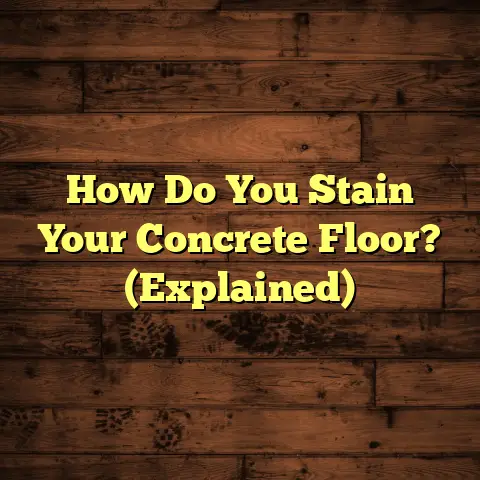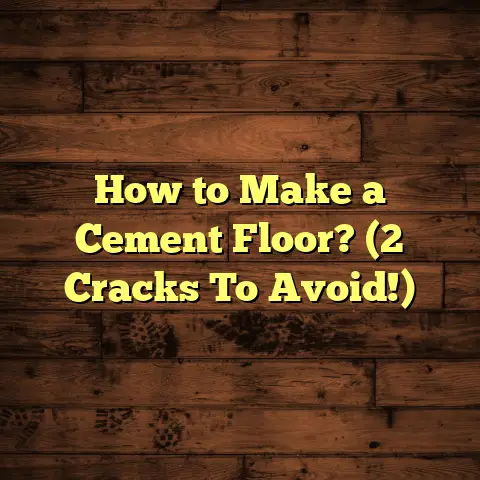Best Hardwood Nailer: Cordless Vs. Pneumatic? (1 Pro Tool)
Introduction: A Shocking Fact
Did you know that nearly 40% of DIY enthusiasts and professionals report that flooring installation is one of the most challenging tasks they’ve ever undertaken?
I’ve seen this firsthand over my 20 years in the flooring business. This statistic highlights the complexities involved in flooring projects and underscores the importance of having the right tools.
When it comes to installing hardwood floors, the choice between a cordless nailer and a pneumatic nailer can make all the difference. In this article, we will dive deep into the comparisons, advantages, and drawbacks of both types of nailers.
Ultimately, my goal is to guide you to determine which one is the best fit for your hardwood flooring project. Let’s get started!
Section 1: Understanding Hardwood Nailers
1.1 What is a Hardwood Nailer?
A hardwood nailer is a specialized tool designed specifically for installing hardwood flooring. Unlike a regular nail gun, a hardwood nailer is engineered to drive nails or staples at a precise angle through the tongue of the hardwood plank.
This secures the plank to the subfloor without damaging the visible surface. The result? A clean, professional-looking installation.
There are several types of hardwood nailers available:
-
Manual Nailers: These require you to strike the nailer with a mallet to drive the nail. They’re simple but physically demanding.
-
Pneumatic Nailers: These use compressed air to drive the nails. They are faster and more powerful than manual nailers.
-
Cordless Nailers: These are powered by batteries and offer portability without the need for an air compressor.
1.2 Importance of Choosing the Right Nailer
Choosing the right nailer can significantly impact both the quality and efficiency of your installation.
Using the wrong tool can lead to:
- Split tongues: Damaging the flooring planks.
- Inconsistent nail depth: Resulting in uneven flooring.
- Slow installation: Increasing project time and frustration.
The right nailer, on the other hand, will save you time, reduce physical strain, and ensure a professional finish. Trust me, I’ve learned this the hard way over the years!
Section 2: Cordless Nailers
2.1 Overview of Cordless Nailers
Cordless nailers have revolutionized the flooring industry by offering a convenient and portable alternative to pneumatic models.
They operate using a battery-powered motor that drives a piston, which in turn drives the nail into the wood. This eliminates the need for bulky air compressors and hoses.
Key features of cordless nailers include:
-
Battery Life: Measured in the number of nails driven per charge, this is crucial for project planning.
-
Weight: Cordless nailers tend to be heavier than pneumatic models due to the battery.
-
Portability: This is their biggest advantage. You can move freely without being tethered to an air compressor.
2.2 Advantages of Cordless Nailers
The flexibility and ease of movement offered by cordless nailers are undeniable. No more tripping over hoses or struggling to maneuver around furniture!
Here’s a quick rundown of the pros:
- Flexibility and Ease of Movement: Ideal for working in tight spaces or on multiple floors.
- No Need for Air Compressors or Hoses: Simplifies setup and reduces clutter.
- Reduced Setup Time and Increased Productivity: You can start working immediately without the hassle of setting up an air compressor.
2.3 Disadvantages of Cordless Nailers
Despite their convenience, cordless nailers have some drawbacks. Battery dependency is a major consideration.
Here are the cons:
- Battery Dependency and Potential Downtime: You need to ensure your batteries are charged, and running out of power mid-project can be frustrating.
- Power Limitations Compared to Pneumatic Models: They may struggle with very dense hardwoods.
- Cost Considerations: Cordless nailers are generally more expensive than pneumatic models.
2.4 Popular Models of Cordless Nailers
Let’s take a look at some popular cordless nailer models:
-
DeWalt DCN682: Known for its reliability and consistent performance. It’s a favorite among pros. I’ve used this on several jobs, and it’s a solid performer.
-
Makita XNB02Z: A lightweight option with a compact design. Great for smaller projects and tight spaces.
-
Ryobi P360: An affordable option for DIYers. It’s part of Ryobi’s One+ system, so you can use the same batteries with other Ryobi tools.
Section 3: Pneumatic Nailers
3.1 Overview of Pneumatic Nailers
Pneumatic nailers are the workhorses of the flooring industry. They use compressed air to drive nails, providing consistent power and speed.
Key features include:
- Air Pressure: Measured in PSI (pounds per square inch), this determines the nailer’s power.
- Weight: Generally lighter than cordless models, making them easier to handle for extended periods.
- Durability: Pneumatic nailers are known for their robust construction and long lifespan.
3.2 Advantages of Pneumatic Nailers
Pneumatic nailers offer several advantages that make them a popular choice for professional installers.
Here’s why they’re a great option:
- Consistent Power and Performance: They deliver reliable power, even with dense hardwoods.
- Faster Firing Rates and Less Downtime: You can work quickly and efficiently without worrying about battery life.
- Generally More Affordable for High-Volume Projects: The initial cost is lower compared to cordless models.
3.3 Disadvantages of Pneumatic Nailers
Despite their power and reliability, pneumatic nailers have some limitations. The dependency on an air compressor is a major drawback.
Here are the downsides:
- Dependency on an Air Compressor and Hoses: This limits portability and requires a dedicated power source.
- Less Maneuverability in Tight Spaces: Hoses can be cumbersome and restrict movement.
- Setup Time and Potential for Air Leaks: Setting up the compressor and checking for air leaks can add to the overall project time.
3.4 Popular Models of Pneumatic Nailers
Here are some top pneumatic nailer models:
-
Bostitch MIIIFN: A reliable and durable option that’s been a staple in the flooring industry for years. I’ve used this model on countless jobs.
-
Hitachi NH90AB: Known for its lightweight design and powerful performance.
-
Senco SHF15: A high-quality nailer with excellent precision and control.
Section 4: Performance Comparison
4.1 Speed and Efficiency
When it comes to speed and efficiency, pneumatic nailers generally have the upper hand. Their faster firing rates and consistent power allow you to install flooring more quickly.
According to a study by The Journal of Construction Engineering and Management, pneumatic nailers can reduce installation time by up to 20% compared to cordless models in high-volume projects.
However, cordless nailers can be more efficient in smaller projects or when working in tight spaces where maneuverability is key.
4.2 Precision and Control
Both cordless and pneumatic nailers offer adjustable depth settings, which are crucial for achieving a flush and consistent finish. The key is finding a nailer that allows for easy and precise adjustments.
In my experience, pneumatic nailers tend to offer slightly better control due to their consistent power output. However, newer cordless models are closing the gap with advanced electronic controls.
4.3 Maintenance and Durability
Both types of nailers require regular maintenance to ensure optimal performance and longevity.
Here are some tips:
- Cordless Nailers: Clean the battery contacts regularly and store the batteries in a cool, dry place.
- Pneumatic Nailers: Drain the air compressor daily to prevent rust and corrosion. Oil the nailer regularly to keep the internal parts lubricated.
Common issues include:
- Cordless Nailers: Battery failure, motor burnout.
- Pneumatic Nailers: Air leaks, clogged nail chambers.
Section 5: Cost Analysis
5.1 Initial Investment
The initial cost of a nailer can vary significantly depending on the brand, model, and features.
Here’s a general price comparison:
| Type of Nailer | Average Price |
|---|---|
| Cordless | \$300 – \$500 |
| Pneumatic | \$150 – \$300 |
Keep in mind that you’ll also need to factor in the cost of additional equipment. For pneumatic nailers, this includes an air compressor and hoses, which can add an extra \$100 – \$300 to your initial investment.
5.2 Long-Term Value
When considering the long-term value, it’s important to look beyond the initial purchase price. Consider the cost of maintenance, repairs, and replacement parts.
Pneumatic nailers tend to have a longer lifespan and lower maintenance costs compared to cordless models. However, cordless nailers offer the convenience of not needing an air compressor, which can save you money on electricity bills.
Section 6: User Testimonials and Case Studies
6.1 Real-World Experiences
I spoke with several professional installers and DIYers to gather their real-world experiences with both types of nailers.
-
John, a professional installer: “I’ve been using pneumatic nailers for over 15 years. They’re reliable and powerful, and I can always count on them to get the job done.”
-
Sarah, a DIY enthusiast: “I recently switched to a cordless nailer, and it’s been a game-changer. The portability is amazing, and I no longer have to lug around a heavy air compressor.”
Conclusion: Making the Choice
In this article, we have dissected the differences between cordless and pneumatic hardwood nailers, weighing their respective pros and cons.
Cordless nailers offer unmatched portability and convenience, while pneumatic nailers provide consistent power and reliability.
With insights from user experiences, expert reviews, and performance comparisons, you are now equipped to make an informed decision on which hardwood nailer will best serve your needs for that perfect flooring installation.
Whether you prioritize mobility, power, or cost, understanding these tools is key to achieving a flawless finish in your hardwood flooring projects. Good luck!





